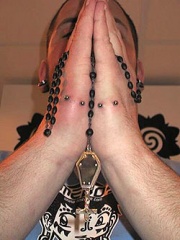|
|
| Line 1: |
Line 1: |
| [[File:DittelSound.jpg|thumb|right|250px|Dittel Sound]] | | [[File:PrayerPiercing.jpg|thumb|right|180px|Prayer piercing]] |
| [[File:HegarSounds.jpg|thumb|right|273px|Hegar Sounds]]
| |
| [[File:PrattDilator.jpg|thumb|right|300px|Pratt Dilator]]
| |
| [[File:Van_Buren_Sound-1.jpg|thumb|right|332px|Van Buren Sound]]
| |
|
| |
|
| '''Sounds''' are smooth medical instruments designed to enlarge the urethra. In a non-medical setting they are used both for urethral stretching, and (more commonly) for highly pleasurable stimulation. It's nothing like a urethral swab. | | The '''prayer piercing''', aptly named in accordance to its placement, is a surface piercing done through the outer edge of the hand. The first published version of this piercing (and the source of the name) was Jason Klym, as done by [[Eric Johanson]] of [[Soul Survivors Body Art]]. This piercing should be treated as a [[Surface piercing|surface piercing]] and [[Rejection|rejection]] is a constant risk. In addition, the placement puts the piercing at eternal risk of damage -- this is definitely a piercing which requires extra special care to be healed successfully. |
| | |
| Sounds need to be cleaned. They can pass disease from user to user if they are being shared. Even if they are not being shared, they can easily lead to bladder infections if not properly cleaned. Ideally, an autoclave should be used, but alternate cleaning includes 10% bleach solutions and pressure cookers.
| |
| | |
| == Types of Sounds ==
| |
| | |
| Urethral sounds come in a variety of styles, and are used in slightly different ways:
| |
| | |
| * '''Dittel sounds''' have a flat end and a rounded end.
| |
| * '''Hegar sounds''' have two rounded ends, are fairly short, and are mildly curved in shape. Hegar sounds are typically the least expensive sounds on the market, and a number of companies online (including [[BMEshop]]) sell them in full sets of eight for as little as $40 - $60. These sets usually consist of slightly curved double-ended sounds starting at small sizes suitable for beginners, right up to absolutely monstrous thumb-sized sounds, for those more experienced people. These sounds are the most safe and comfortable for the female anatomy.
| |
| * '''Henk sounds''' have a more pronounced curve at the ends, as well as a metal rib on each end.
| |
| * '''Pratt sounds''' are longer urethral dilators (double ended ones are usually almost a foot long) with rounded and slightly bent ends. Many men enjoy them for sounding.
| |
| * '''Van Buren sounds''' have a very pronounced curve at each end, specifically for the purpose of reaching the [[Bladder]].
| |
| | |
| == Jewelry ==
| |
| | |
| The body modification link to sounding is jewelry that incorporate sounds in them such as:
| |
| | |
| * [[Prince's Wand]]
| |
| * [[Pound Puppy]]
| |
| | |
| == See Also ==
| |
| | |
| * [[Transurethral]]
| |
| * [[Dolphin]]
| |
| * [[Subincision]]
| |
| * [[Urethra]]
| |
| * [[Meatotomy]]
| |
| * [[UTI]]
| |
| * [[Sounding]]
| |
The prayer piercing, aptly named in accordance to its placement, is a surface piercing done through the outer edge of the hand. The first published version of this piercing (and the source of the name) was Jason Klym, as done by Eric Johanson of Soul Survivors Body Art. This piercing should be treated as a surface piercing and rejection is a constant risk. In addition, the placement puts the piercing at eternal risk of damage -- this is definitely a piercing which requires extra special care to be healed successfully.
